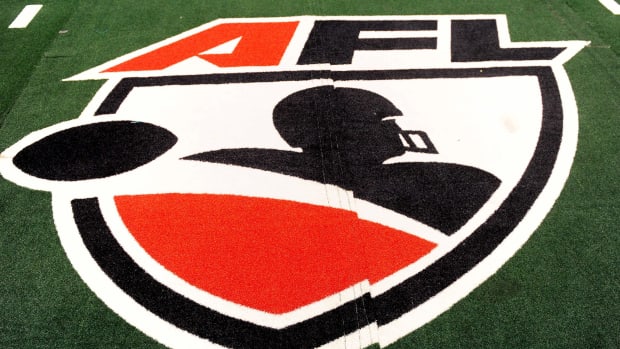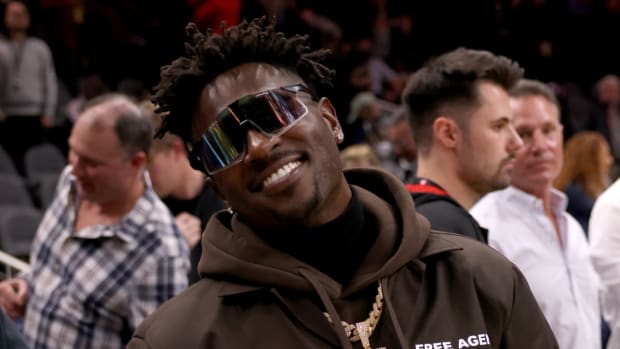How the first fan-run football team was born
Your teams on the go or at home. Personalize SI with our new App. Install on iOS or Android.
Sohrob Farudi wanted to be Jerry Jones when he grew up. At 10 years old he didn’t know it yet, but the entrepreneurial spirit he later found he shared with the Dallas Cowboys owner was evident from a young age. He walked the hallways of his elementary school selling candy bars and set up lemonade stands with his brothers on warm days in south Texas, accepting quarters to fund his baseball card and video game collections.
Growing up a Cowboys fan, he spent Sundays on the couch with his brothers, yelling at his television after play calls he disagreed with failed and groaning while a player he didn’t want the team to sign turned in yet another bad game.
“I always thought about if we were ever successful enough to own a team, what would we do differently?” Farudi said. “Our thought was, you know what if we can crowdsource this, and we can give an army of fans the ability to have an impact and control over what happens on the field, why can’t fans be successful?”
This idea sparked conversation with his brothers, from which the concept for the first fan-run football team in history—dubbed Project FANchise—was eventually born.
Project FANchise began on Farudi’s couch, but it grew from the convergence of three ideas from three different men with the same desire—to involve fans in the decision-making aspects of the game.
The team behind the team
By 2015, Farudi had fallen in love with the game of indoor football. He was briefly a minority owner of an Arena Football League team, and despite his breakup with the team last June, his affinity for the game persisted and he began doing research on how to bring his idea of a fan-run team to the arena.
As he researched, he stumbled upon a 2008 New York Times article on Project Franchise, an enterprise that intended to use budding technology to enable fans to run a minor league baseball team. The venture was the right idea at the wrong time. Expenses and underdeveloped technology made it impossible to continue, and eventually the project failed. But seven years later Farudi connected with one of its founders, Grant Cohen, with the proposition of reviving his idea and combining it with his own. Cohen’s response? “Let’s do it.”
Marshawn Lynch confirms retirement in joint SI/60 Minutes segment
The next addition to the team was former Chicago Bears defensive back Ray Austin. After his three seasons in the NFL, Austin had developed an app called Snap Count, which was intended to allow fans to call plays in real time during games. He had been in contact with the AFL and Indoor Football League, but when he was approached by Farudi he realized how much broader his idea could be taken.
“Three different people looking at the same concept in a little different way,” Farudi said. “When we all came together, it happened to be perfect timing for us.”
Farudi, Cohen and Austin joined forces with three other technology entrepreneurs of varying backgrounds—Vivek Jain, Patrick Dees and Andrew Berman—and presented their idea to the IFL last August at the owners meetings in Las Vegas. Though the IFL owners weren’t quite daring enough to implement the concept with their own teams, Farudi said they loved the idea of the Project FANchise guys trying it on an expansion team. So Farudi & Co. purchased a team that was officially introduced to the league in May as a team with no name. A helmet with a question mark sat on the table at the introductory press conference, suggesting not doubt but possibility.
• KING: The NFL world remembers Muhammad Ali
How it works
Project FANchise combines Farudi’s desire for fan empowerment, Cohen’s technology background and Austin’s mobile playbook, producing a high stakes fantasy team.
“We want to replace [fantasy football],” Austin said. “And say, ‘Hey, instead of being a fantasy football guy and wishing and hoping, here’s a chance for you to actually develop your whole team yourself.’”
The Project FANchise team will operate just as any other NFL or IFL team does, just with the people who love it the most calling the shots.
Vikings give Harrison Smith the contract to match his elite value
But not every fan will be created equal. Fans must prove their knowledge of the game and their commitment to the team by being tested on their Fan IQ. Through the Project FANchise app, fans will earn points toward their IQ by taking a series of daily quizzes. Each fan who downloads the app begins as a rookie who has voting power over the most basic decisions—choosing the location, team colors, etc—but they can all work their way up to Hall of Fame status, which would allow them to call plays on fourth down in the waning minutes of a tie game.
The founders know that giving the fans this unparalleled access to team decision-making is risky—how many fantasy players grow bored of their teams just a few weeks into the season?—but they are trusting the fans to be educated and stay committed.
“That’s part of the excitement,” Farudi said. “This is a big social experiment. We are literally putting this team’s fortunes in your hands. What are you going to do with it? Are you going to take it seriously? Are you going to build a championship team? Or are you going to forget about it Week 3 and not set your lineup? And are we going to lose because you didn’t take it seriously? It’s really putting the power in the fans’ hands, and they have to take it seriously to make it happen.”
• PIERCE: Can the NFL escape the depths of its own corruption?
Live streaming practices, watching game film alongside the players, listening to coaches’ podcasts and web seminars, taking in the view of the field from the quarterback’s helmet camera are all part of the ownership’s plan to create an entirely involved, immersive experience in order to increase the emotional attachment of the fans to the team.
And the fans have already started showing their commitment. Over 20,000 people had signed up on the team’s website before it even had a name, eclipsing the average attendance at an IFL game by five times, and donors have already surpassed the $50,000 goal to fund the finalization of the app.
Fans are rewarded for that commitment by a promise from the founders to never override their control of the team.
Marshawn Lynch’s replacements: A look at Seattle’s current RB situation
“This isn’t going to be a Boaty McBoatface situation,” Farudi said, referring to the British research vessel that the government decided to re-name after deciding the crowdsourced name was too silly. “I’m okay with being the Football McFootballfaces if that’s what the fans want. I think we’ll sell a hell of a lot of merchandise.”
Some fans decided that’s what they did want, and the Utah Teamy McTeamface finished in the top 10 of the fan vote for the team name. Ultimately the traditionalists and the Salt Lake Screaming Eagles won out, illustrating that Farudi’s trust in the people of the Internet was not misguided. (As for the location choice, the owners narrowed down the cities to Salt Lake City and Oklahoma City, and Salt Lake won the fan voting).
The online access to the team has already united people from all over the globe. From interested players hailing from Kenya and Finland, to fans accessing the website from the UK and Canada, to their fan adviser and Battle of the Fans winner Pedro Arnau providing counsel from Mexico City—anyone with a computer or a smartphone can contribute.
After 2016, Patriots’ future murky as cap and free agency questions loom
Farudi’s theory is that as the fans are given more opportunities to connect with the team and take true ownership of it, their emotional investment in its success will grow beyond that of even the diehard NFL fans who have no real connection to their teams besides perhaps geographical proximity. Instead, the Project FANchise fans will develop a relationship with their team that stems from their ability to make a difference.
“I think that changes your sense of being a fan,” Farudi said. “And that’s what we’re trying to do here, is create a whole different meaning of what a fan is. That’s what this Project FANchise is all about.”
Just the beginning?
At the IFL owners meetings, Farudi and his partners were approached by several owners inquiring whether they were building the technology that would allow them to apply the Project FANchise concept to their own teams if the venture was successful. Farudi’s answer: Absolutely.
“The big idea is a fan-run league,” Farudi said.
• QBs with the most to prove in 2016 | 10 head coaches under pressure
With help from NFL veterans such as Austin, Ahman Green—the Green Bay Packers all-time leading rusher and former co-owner of the IFL’s Green Bay Blizzard—former Denver Broncos All-Pro Al Wilson, former San Francisco 49ers COO Andy Dolich and more, Farudi is hoping to surround the Screaming Eagles with enough star-powered endorsements to attract the attention that would make a fan-run league possible.
The Project FANchise owners aren’t the first to devise the idea for a fan-run team—Cohen’s own Project Franchise attempted it in minor league baseball, “Fan Club: Reality Baseball” tried giving managerial power over an independent league team to the fans in 2006 and baseball legend Bill Veeck hosted Grandstand Manager Night with MLB’s St. Louis Browns in 1951, during which fans held up placards indicating whether they agreed with certain in-game managerial decisions. Still, Green thinks Project FANchise could be the most successful fan-run team, and signed on to help because he believes the online community is finally prepared to make a venture like this work.
Truth Detector: Will Trevor Siemian really be Manning's replacement?
“When Ray told me what he was doing I was like ‘I’m in!’ because I know where the technology industry is going, especially in the sports world or the e-sports world,” Green said. “This is going to be just as big as us watching Monday Night Football down the road. Because that’s where the world is going.”
Over the years, as Farudi has drawn from the ownership example set by Jones, he came to understand the special connection between being a fan and being an owner. He saw Jones's love for the Cowboys and compared it with his own, realizing how much more meaningful it must be to cheer for a team whose success you actually have some control over.
“You don’t stop being a fan as an owner of a team. In fact you’re probably the biggest fan there is, Farudi said. “And to be in that position where you can actually have an impact on a team that you love…to me that’s what’s exciting about what we’re doing. We’re putting every fan in that position to feel like this is their team. They get to really have a say in who coaches it, who plays on it.
“To me that is the ultimate ownership/fan experience. I don’t know that it gets any better.”




